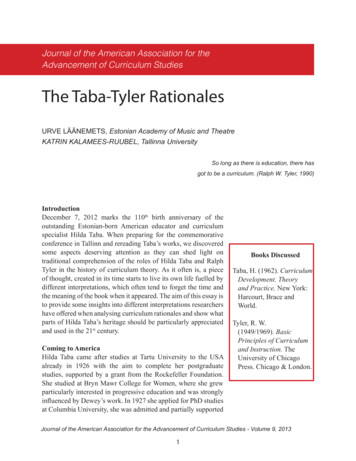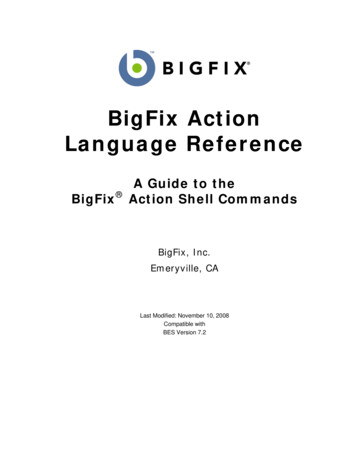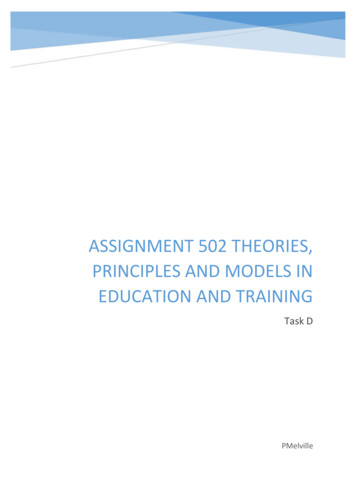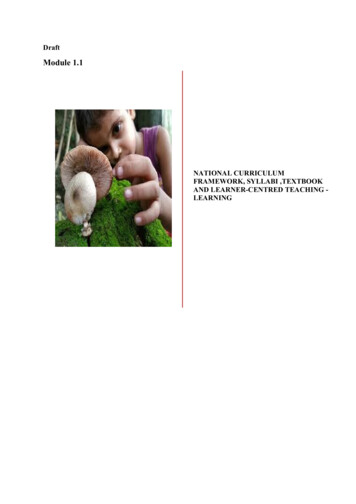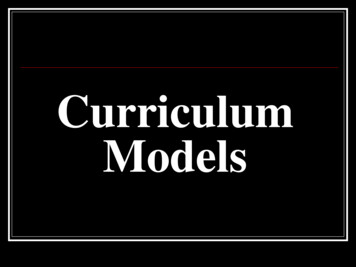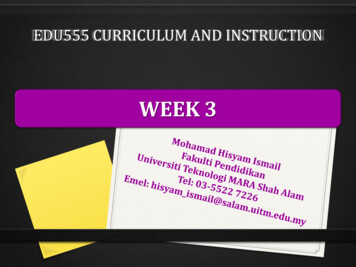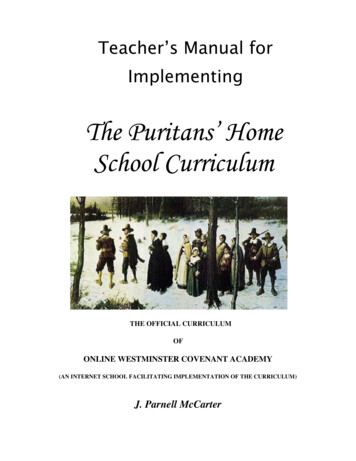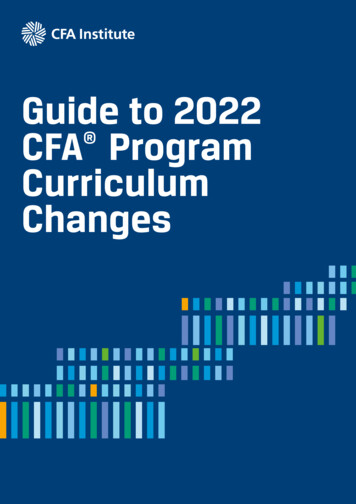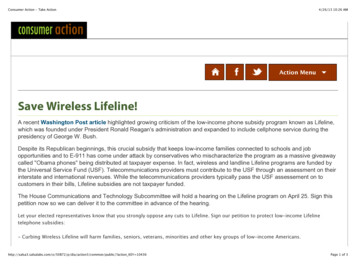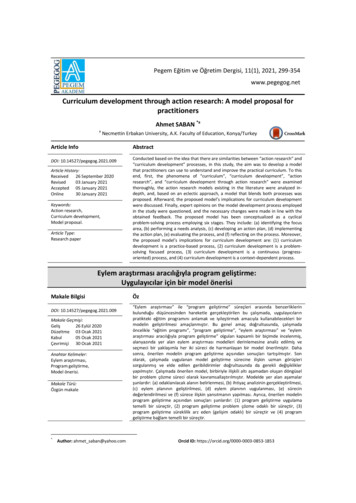
Transcription
Pegem Eğitim ve Öğretim Dergisi, 11(1), 2021, 299-354www.pegegog.netCurriculum development through action research: A model proposal forpractitionersAhmet SABAN *aaNecmettin Erbakan University, A.K. Faculty of Education, Konya/TurkeyArticle InfoAbstractDOI: 10.14527/pegegog.2021.009Conducted based on the idea that there are similarities between “action research” and“curriculum development” processes, in this study, the aim was to develop a modelthat practitioners can use to understand and improve the practical curriculum. To thisend, first, the phenomena of “curriculum”, “curriculum development”, “actionresearch”, and “curriculum development through action research” were examinedthoroughly, the action research models existing in the literature were analyzed indepth, and, based on an eclectic approach, a model that blends both processes wasproposed. Afterward, the proposed model’s implications for curriculum developmentwere discussed. Finally, expert opinions on the model development process employedin the study were questioned, and the necessary changes were made in line with theobtained feedback. The proposed model has been conceptualized as a cyclicalproblem-solving process employing six stages. They include: (a) identifying the focusarea, (b) performing a needs analysis, (c) developing an action plan, (d) implementingthe action plan, (e) evaluating the process, and (f) reflecting on the process. Moreover,the proposed model’s implications for curriculum development are: (1) curriculumdevelopment is a practice-based process, (2) curriculum development is a problemsolving focused process, (3) curriculum development is a continuous (progressoriented) process, and (4) curriculum development is a context-dependent process.Article History:Received26 September 2020Revised03 January 2021Accepted 05 January 2021Online30 January 2021Keywords:Action research,Curriculum development,Model proposal.Article Type:Research paperEylem araştırması aracılığıyla program geliştirme:Uygulayıcılar için bir model önerisiMakale BilgisiDOI: 10.14527/pegegog.2021.009Makale Geçmişi:Geliş26 Eylül 2020Düzeltme 03 Ocak 2021Kabul05 Ocak 2021Çevrimiçi 30 Ocak 2021Anahtar Kelimeler:Eylem araştırması,Program geliştirme,Model önerisi.Makale Türü:Özgün makale*Author: ahmet saban@yahoo.comÖz“Eylem araştırması” ile “program geliştirme” süreçleri arasında benzerliklerinbulunduğu düşüncesinden hareketle gerçekleştirilen bu çalışmada, uygulayıcılarınpratikteki eğitim programını anlamak ve iyileştirmek amacıyla kullanabilecekleri birmodelin geliştirilmesi amaçlanmıştır. Bu genel amaç doğrultusunda, çalışmadaöncelikle “eğitim programı”, “program geliştirme”, “eylem araştırması” ve “eylemaraştırması aracılığıyla program geliştirme” olguları kapsamlı bir biçimde incelenmiş,alanyazında yer alan eylem araştırması modelleri derinlemesine analiz edilmiş veseçmeci bir yaklaşımla her iki süreci de harmanlayan bir model önerilmiştir. Dahasonra, önerilen modelin program geliştirme açısından sonuçları tartışılmıştır. Sonolarak, çalışmada uygulanan model geliştirme sürecine ilişkin uzman görüşlerisorgulanmış ve elde edilen geribildirimler doğrultusunda da gerekli değişiklikleryapılmıştır. Çalışmada önerilen model, birbiriyle ilişkili altı aşamadan oluşan döngüselbir problem çözme süreci olarak kavramsallaştırılmıştır. Modelde yer alan aşamalarşunlardır: (a) odaklanılacak alanın belirlenmesi, (b) ihtiyaç analizinin gerçekleştirilmesi,(c) eylem planının geliştirilmesi, (d) eylem planının uygulanması, (e) sürecindeğerlendirilmesi ve (f) sürece ilişkin yansıtmanın yapılması. Ayrıca, önerilen modelinprogram geliştirme açısından sonuçları şunlardır: (1) program geliştirme uygulamatemelli bir süreçtir, (2) program geliştirme problem çözme odaklı bir süreçtir, (3)program geliştirme süreklilik arz eden (gelişim odaklı) bir süreçtir ve (4) programgeliştirme bağlam temelli bir süreçtir.Orcid ID: https://orcid.org/0000-0003-0853-1853
Ahmet SABAN – Pegem Eğitim ve Öğretim Dergisi, 11(1), 2021, 299-354IntroductionIt is thought that the curriculum field has witnessed many significant turning points since itsemergence as a discipline in 1918. For instance, during the 1970s, the curricularists were called toimmediately abandon the modern paradigm-related practices and embrace a curriculum perspectivecompatible with the postmodern paradigm. Many critics (Eisner, 1984; Huebner, 1976; Kliebard, 1970,1995; Pinar, 1999; Pinar, Reynolds, Slattery, & Taubman, 1995; Reid, 1979) of the modern paradigm,associated primarily with Bobbitt’s, Tyler’s and Taba’s curriculum development thoughts, suggested thatwe need to go beyond this paradigm by removing the traces of our past. For example, Pinar et al. (1995)claimed that, alas, the traditional curriculum development era was already past, that the idea of howbest to develop a curriculum was born in 1918 (with Bobbitt’s book “The Curriculum”) and ended up in1969 (with Schwab’s article “Practical: A Language for Curriculum” in which he declared that thecurriculum field was moribund), and that other concepts such as objectives, design, implementation, orevaluation related with the traditional curriculum development thought were no longer underconsideration.These critics who called themselves “the re-conceptualists” are said to have three noticeablefeatures (Jackson, 1980, 1992; Pinar, 1994, 1999; Pinar et al., 1995): (1) being discontent with Tyler’scurriculum development model, (2) trying to understand the curriculum phenomenon in light ofmultiple perspectives (such as the psychoanalytic approach, autobiography, the hermeneutic approach,post-structuralism, existentialism, and phenomenology), and (3) being deeply concerned withcontinuing political or social issues (such as culture, gender, race, history, ethics, aesthetic, or religiousorientation). The traditional curriculum development era was also criticized for lacking a theoretical andhistorical basis and being influenced by subject matter experts, textbook publishers, or centralpoliticians (Apple, 1983, 1985; Kliebard, 1970, 1995; Reid, 1979).In short, the re-conceptualists focused on understanding the curriculum phenomenon from differenttheoretical and methodological perspectives rather than curriculum development. They also embracedthe concept “curriculum” instead of “curriculum development” and the description “curricularist” ratherthan “curriculum development specialist.” As Pinar et al. (1995, p. 6) stated, the curriculum field “is nolonger preoccupied with development . the field today is preoccupied with understanding.” However,what was meant by this statement is that it is not that the curricularists will no longer engage incurriculum improvement, but that the traditional curriculum development thought had come to an end.Nonetheless, no one point of view or approach is described as the re-conceptualist stance in theliterature. Instead of criticizing Tyler’s curriculum development model, some educators (Hlebowitsh,1999, 2005; Hunkins & Hammill, 1994; Wraga, 2017) also argued that he acted according to his time’sparadigm appropriately. According to them, if we want to go beyond Tyler’s model, we must first beaware of and appreciate his contribution to the curriculum field. It is also important to note that wewould not be discussing the essence of a new paradigm without Tyler’s thoughts. Additionally, it wouldbe reasonable to analyze modern and postmodern paradigms’ basic assumptions to understand betterBobbitt’s, Tyler’s, and Taba’s curriculum development ideas and the re-conceptualists’ criticismsregarding them. Only in this way, the curricularists could start a new dialogue on how best to undertakecurriculum development in practice without worrying too much about the consequences of supporting aparadigm (Hlebowitsh, 2010).According to Pinar et al. (1995, p. 12), the concept “paradigm” mostly refers to “a general mind-setor perspective which dictates, for example, in which directions research might go, what constituteslegitimate knowledge, and who is a legitimate speaker for the field.” In this respect, modernism is notsynonymous with contemporaneousness. The modern paradigm, which started with the industrialrevolution in the 18th century, adopted the positivist thought (Hunkins & Hammill, 1994). The modernparadigm’s most distinctive feature is its tendency to view ideas and actions as “mechanical”,“objective”, and “definite”. The modern paradigm’s basic assumptions are (Pinar et al., 1995):300
Ahmet SABAN – Pegem Eğitim ve Öğretim Dergisi, 11(1), 2021, 299-354 People in the same conditions have the same experiences. The majority’s opinions determine the truth. Generalization is more critical than individual viewpoints. People can be used as a means to the ends. Objectivity is possible and constitutes the norm.On the contrary, the postmodern paradigm rejects the view that the universe operates mechanically.Instead, it highlights the “complexity”, “dynamicity”, and “unpredictability” of reality or phenomena.The postmodern paradigm’s essential assumptions include (Barrow, 1999): There are no such big facts about the world but only different ways of looking at the world. There is no unbiased knowledge; all knowledge is based on personal views or narratives. Concepts like meaning, value, and truth are context-dependent phenomena. Our thoughts are not independent entities but rather part of our belief systems. Our belief systems are the products of our languages and could be infinitely varied. Our disagreements are purely a matter of our varying belief systems.One of the most critical debates regarding modern and postmodern paradigms has been on “how toproduce legitimate knowledge”. For instance, whereas the modern paradigm has been associated withquantitative research’s widespread use in education, the postmodern paradigm has been characterizedby qualitative research’s dominance. A particular emphasis has also been put on “action research” tounderstand and improve the curriculum in a specific context (Clandinin & Connelly, 1992; Jackson,1992). As Carson (1990, p. 167) pointed out: “Despite the different forms it takes, all action research hasa common intention: the belief that we may develop our understandings while at the same timebringing about changes in concrete situations.”Recently, it is thought that the curriculum field is witnessing two different calls and at a crossroads interms of these calls: (1) “a call for a more centralized or standardized curriculum” and (2) “a call for amore local or contextual curriculum”. It is believed that both calls have legitimate foundations, eithersupported or criticized by educators around the world. It is also thought that whereas “the first call”views the curriculum from a more “political” concern, “the second call” conceives it from a more“practical” point of view. For example, according to Apple (1993, p. 222), a society’s power structure“intrudes into the very heart of curriculum, teaching, and evaluation.” Thus, such questions as “whatcounts as knowledge, the ways in which it is organized, who is empowered to teach it, what counts as anappropriate display of having learned it,” and most importantly, “who is allowed to ask and answer all ofthese questions” are pretty much a reflection of “how dominance and subordination are reproducedand altered” in a society.In short, adherents of “the first call” argue that the curriculum content must be conceptualizedwithin the national context (Karseth & Sivesind, 2010). According to them, “the 21st-centurycompetencies needed in the knowledge society can be regarded as the overall rationale and goals forlearning” (Voogt & Roblin, 2012, p. 301). In this respect, the curriculum becomes more like a “politicaltext” (“a means by which the official curriculum is ensured”). Meanwhile, this approach assumes a linearrelationship between the “official” and “real” (implemented) curricula. Nevertheless, the currentliterature suggests that a nationally standardized curriculum does not move directly into classrooms, for“it is continuously adapted and transformed by teachers” (Mathou, 2008, p. 790). As Voogt and Roblin(2012, p. 301) point out, there is “a gap between the needs of the knowledge society expressed by theadvocates of 21st-century competencies and the ways in which these competencies are addressed innational and school curricula.” Consequently, educators making “the first call” have ended up suggestingmore and more standardized testing to take place in schools to determine whether expected learningoutcomes are achieved. However, in the literature, it is also emphasized that the more teachers’ in-classpractices are controlled with standardized tests, the more “teaching-to-the-test” type of practices arewitnessed in schools (Au, 2011; Tanner, 2013).301
Ahmet SABAN – Pegem Eğitim ve Öğretim Dergisi, 11(1), 2021, 299-354On the contrary, adherents of “the second call” (Connelly, 2013; Deng, 2013, 2018; Westbury, 2013;Wraga & Hlebowitsh, 2003) mainly argue that the curriculum field should be returned to where itbelongs. These educators criticize the re-conceptualists and claim that they misinterpreted both Tyler’sand Schwab’s ideas and that, far from offering practical solutions, caused more confusion in thecurriculum field. These educators blame the re-conceptualization movement for breaking away thecurriculum field from schools’ and classrooms’ realities and failing to provide a logical framework forimproving educational practice. Some of them even contend that the curriculum field is nowexperiencing an “identity problem” more than ever.For example, by analyzing the curriculum field’s current status that has emerged in light of the reconceptualization movement since the 1970s, Deng (2018) claimed that the curriculum field is now in asevere crisis. According to Deng, due to its mere emphasis on understanding the curriculum fromdifferent theoretical perspectives and conscious rejection of its practical dimension, the reconceptualization movement caused the contemporary curriculum studies to diverge the curriculumfrom its core. Hlebowitsh (2012, p. 9) also pointed out:“[Today] the field of curriculum studies has become decoupled from the lives of school people. .Today theory reigns over practice in the curriculum studies field; ideations about schools reign overactual involvements with them and speaking to the academy reigns over speaking to practitioners.”Accordingly, the fundamental question regarding the curriculum field’s current status is: How canthe curriculum field be returned to its core to overcome the problems inherent in the traditionalcurriculum development approach, on the one hand, while focusing on improving educational practiceson the other hand? This study was carried out in line with this need (question) as a proposal. Conductedbased on the idea that there are similarities between “action research” and “curriculum development”processes, in this study, the aim was to develop a model that practitioners can use to understand andimprove the practical curriculum. In this way, it is intended to provide a systematic and scientificapproach to practitioners to solve the contextual curriculum problems. It is also thought that this studywill contribute to the conceptualization of the curriculum field anew. As Burnaford, Beane andBrodhagen (1994, p. 7) pointed out powerfully:“Viewing action research as curriculum, rather than something being done to curriculum, is a shift indefinition. Such a curriculum continues to be active, as teachers and students try and retry, test andretest, act and react, write and respond to each other.”Method: The Model Development ProcessThe idea of model development in education is based on Borg’s (1987) study entitled “TheEducational R & D Process: Some Insights”. In this respect, Halloun (2007) states that models can bedeveloped based on two approaches, either through (1) “the interpretation of data collected during aresearch process” or (2) “a critical analysis and synthesis of theoretical ideas in the literature”. The studyconducted by Lambirth et al. (2019) can be given as an example of the first approach. In their study,Lambirth et al. introduced an action research model developed in a professional development courseattended by more than 150 primary and secondary school teachers for about four years. The model isbased on data collected through in-depth interviews with 28 teachers, analysis of project reports, andproject facilitators’ field notes. The model identifies five stages of teacher-led action research andhighlights some of the issues to be considered in each stage: (1) “defining the field of action”(professional concerns, focus area), (2) “planning” (research skills, critical thinking), (3) “action”(contextual power relations, ethical awareness) (4) “evaluation” (peer review, practical implications),and (5) “reflection” (transformation, sustained change).The present study, on the other hand, used Halloun’s (2007) second approach. In this regard, thestudy employed a five-phase model development process based on reviewing the current literature andgathering expert opinions. Figure 1 visualizes the model development process employed in this study.302
Ahmet SABAN – Pegem Eğitim ve Öğretim Dergisi, 11(1), 2021, 299-354Figure 1. Model Development Process.Accordingly, the present study’s content has been organized based on the phases defined in Figure1. These phases are: (1) “inspiration”, (2) “exploration”, (3) “design”, (4) “reflection”, and (5)“feedback”. In the following sections, each of these phases is addressed sequentially andcomprehensively under a separate title. To explain them briefly here:The first phase (the inspiration phase) addresses the emergence of the model development idea andthe researcher’s perspective on the curriculum phenomenon.The second phase (the exploration phase) examines the phenomena of “curriculum”, “curriculumdevelopment”, “action research”, and “curriculum development through action research” thoroughly.The third phase (the design phase) introduces the study’s model and its main characteristics.The fourth phase (the reflection phase) discusses the proposed model’s implications for curriculumdevelopment.The second, third, and fourth phases required a continual examination of the existing literature,reading/re-reading a substantial amount of books and journal articles related to action research andcurriculum development processes, and a significant amount of thinking and reflection.Finally, the fifth phase (the feedback phase) inquires expert opinions on the model developmentprocess employed in the study and highlights the changes in line with the obtained feedback.Phase 1: The Inspiration PhaseThe inspiration for the model development idea dates back to when the organizing committee of the“7. International Congress on Curriculum and Instruction (ICCI-2019)” invited the researcher toparticipate in it as a panelist. Ankara University Faculty of Educational Sciences in Turkey held theCongress between 09 and 12 October 2019 on “Redesigning the Future in the Light of CurriculumStudies”. So when the committee invited the researcher to give a speech in the panel “CurriculumDevelopment Studies: From Past to the Future”, he wondered:303
Ahmet SABAN – Pegem Eğitim ve Öğretim Dergisi, 11(1), 2021, 299-354 Can action research be considered as a curriculum development model? How can action research contribute to a better understanding of the curriculum developmentprocess? At what level (centralized or local) does action research envision curriculum development to occur? How does the idea of curriculum development through action research fit into the on-going debateswithin the context of modern and postmodern paradigms? Are the practitioners at the same time action researchers? Should they be? Why? What are the implications of action research for practitioners?The literature states that this type of questioning practice can also be used as a means of selfreflection. For instance, Pinar et al. (1995) argue that regardless of whether they are theoretical orpractical, all contemporary curriculum studies should include such features as “self-reflection”, “selfunderstanding”, and “interpretation of self-experiences”. In this regard, Heikkinen, Huttunen and Syrjala(2007) state that action research studies are often “narratives” located in researchers’ evolvingexperiences. Similarly, Brydon-Miller, Greenwood and Maguire (2003, p. 12) encourage educators toself-reflect on their action research studies in terms of the following questions:“Why do you choose to do action research? What brought you to this practice? What keeps youinvolved? Do you have particular stories that illustrate why you practice action research? Whatissues, values, experiences, personal characteristics, or other factors underlie your commitment toaction research and shape your practice?”From this perspective, the researcher’s approach to action research as a teacher educator working inthe “Curriculum and Instruction” field is based on the belief that teachers can use action research tounderstand and improve the practical curriculum. Putting it in Kincheloe’s (2016, p. 611) words:“I have a vision of teachers who are self-directed scholar-professionals who produce their ownknowledge and diagnose the needs of their students. . A key dimension of the effort to becomeself-directed professionals involves teachers operating as curriculum developers.”Hence, looking from the action research perspective, teachers are not merely transmitters of theexternally developed curriculum. Instead, through their joint actions, interactions, and experiences withtheir students in the classroom, they reconstruct it. In sum, the curriculum’s source and authority residein teachers’ hands in this research type, but not in the external bodies.Phase 2: The Exploration PhaseAt this phase, the phenomena of “curriculum”, “curriculum development”, “action research”, and“curriculum development through action research” are analyzed in-depth. In this way, it is aimed toestablish a sound theoretical basis for the proposed model.Understanding the Curriculum PhenomenonIn terms of its etymological origin, the concept “curriculum” means “racecourse” or “racetrack” inLatin (Jackson, 1992). Today, this concept generally refers to both “a field of study” at universities and “afield of practice” in which the practitioners work (Ornstein, 1987). Nevertheless, there are many debatesand misunderstandings among educators about what precisely is meant by the curriculum concept.After reviewing textbooks related to the curriculum field, Rogan and Luckowski (1990) emphasized thatthe curriculum field was piecemeal and that no consensus existed among educators regarding what itshould cover.For instance, Beauchamp (1972, p. 18) defined the curriculum as “a document designed to be usedas a point of departure for instructional planning.” This definition classifies the curriculum as a productrather than a process, views it as a different entity from instruction, and places it before instruction.304
Ahmet SABAN – Pegem Eğitim ve Öğretim Dergisi, 11(1), 2021, 299-354However, the major problem with Beauchamp’s definition is that it is more of a description than adefinition. As Posner (1973/1974, p. 58) clarifies:“The reason for not considering it a definition is that it does not tell us of what a curriculum consists.Beauchamp claims that a curriculum is a document. But what makes up this document? The secondpart of his description tells us not what makes up the document, but, instead, what role thedocument is to serve.”Various definitions of curriculum have been provided in the literature, which has created muchconfusion. For example, Rule (1973) identified 119 different curriculum meanings. Portelli (1987), on theother hand, classified the curriculum definitions thus far offered in the literature under the followingthree broad categories: (1) “curriculum as content”, (2) “curriculum as a plan”, and (3) “curriculum asexperience”. Whereas “curriculum as content” describes the knowledge to teach to students throughsuch subjects as mathematics, science, or history in schools, “curriculum as a plan” is conceptualized asa blueprint or a written document of educational activities prepared for a teaching or learning purpose.These two definitions represent the most traditional curriculum meanings, viewing it as a concretedocument (a textbook, a guide) to be followed by teachers. They also treat the curriculum andinstruction as two separate entities by making a clear distinction between them and placing thecurriculum before instruction.On the contrary, “curriculum as experience” represents the sum of students’ learning experiencesunder schools’ guidance, either planned or unplanned. Progressive and humanist educators mostlyembrace this curriculum view. However, it is thought that this definition refers more to instruction thanthe curriculum, and hence implies that the curriculum also subsumes instruction (Johnson, 1981). Thissituation also makes one wonder about the temporal relation of the curriculum to instruction. Indeed,the confusion about what the curriculum means is based on an argument or disagreement aboutwhether it should subsume instruction (Egan, 1978). For example: Should the curriculum come beforeinstruction, should it be addressed simultaneously with instruction, or should it be an end report ofinstruction?In this regard, Oliva (1982) provides a very comprehensive and illuminating analysis. According tohim, four types of relationships exist between the curriculum and instruction: (a) “dualistic”, (b)“interlocking”, (c) “concentric”, and (d) “cyclical”. In short, “the dualistic approach” views the curriculumand instruction as two different and independent entities, indicating no relationship between them.“The interlocking approach” describes an interdependent relationship between the curriculum andinstruction, with neither of them assuming a dominant role. It states that viewing the curriculum andinstruction as two separate entities can damage both of them. “The concentric approach” regards thecurriculum and instruction as two intertwined phenomena, with one subsuming the other, meaning thatthe curriculum either subsumes instruction or becomes an integral part of it. Finally, “the cyclicalapproach” emphasizes the importance of feedback between the curriculum and instruction. Althoughthis approach views them as two distinct phenomena, it implies that instructional decisions are to bemade after curricular decisions, which are to be made after instructional decisions are put into action.The relationship between them is continuous, cyclical, and never-ending.Accordingly, it can be suggested that the curriculum and instruction are two different phenomenathat are both independent and interdependent, i.e., they cannot function in isolation from one another.Besides, for teachers, the distinction between the curriculum defined as the ultimate ends andinstruction serving as a means to achieve these ends is irrelevant mainly because, as Clandinin andConnelly (1992, p. 365) state:“Teachers and students live out a curriculum; teachers do not transmit, implement, or teach acurriculum and objectives, nor are they and their students carried forward in their work and studiesby a curriculum of textbooks and content, instructional methodologies, and intentions. An account ofteachers’ and students’ lives over time is the curriculum, although intentionality, objectives, andcurriculum materials do play a part in it.”305
Ahmet SABAN – Pegem Eğitim ve Öğretim Dergisi, 11(1), 2021, 299-354Nevertheless, the reader’s mind may get more confused with many other definitions existing in theliterature to emphasize the differentiation between the “planned curriculum” and “unplannedcurriculum”. For example, the literature offers such conceptualizations as the “hidden curriculum”(Jackson, 1968), the “unwritten curriculum” (Dreeben, 1976), and the “unstudied curriculum” (Overly,1970) to describe the unintended learning outcomes in education. There are also such definitions as the“null curriculum” (Eisner, 1985) to emphasize what is untaught or missing in schools and the “out-ofschool curriculum” (Schubert, 1981) to point to the extra-curricular activities. Accordingly, the “hiddencurriculum” reflects both the official curriculum’s ideological and subliminal messages and thephenomena not addressed by the official curriculum (Jackson, 1992; Yüksel, 2002).Understanding the Curriculum Development PhenomenonAs the concept “curriculum”, the phrase “curriculum development” is also considered an ambiguousconcept, for it implies many phenomena simultaneously and, hence, is valued as a contradictory conceptto define. For instance, the following points can be implied with curriculum development: A packaged curriculum had been designed at some point in time, Such the curriculum package has already been implemented, During its implementation, some deficiencies needing improvement have been identified, An improvement process should be carried out to overcome these deficiencies, and An ideal curriculum would emerge as a result of the improvement efforts.However, it is difficult to separate such phenomena from one another with such sharp boundaries orto observe them occurring linearly in real life. Curriculum development is not just an action that simplylasts until instruction begins. Instead, it is a continuous process of evaluation and improvement ofinstruction while still in progress. In reality, it is not possible to develop a curriculum at a specific time orplace and then apply it at another time or place (Schwab, 1983). The curriculum is constructed throughteachers’ and students’ actions and interactions during the teaching-learning process. Therefore, suchconceptual distinctions as “curriculum design”, “curriculum implementation”, “curriculum
curriculum development model, (2) trying to understand the curriculum phenomenon in light of multiple perspectives (such as the psychoanalytic approach, autobiography, the hermeneutic approach, . They also embraced the concept curriculum _ instead of curricu

